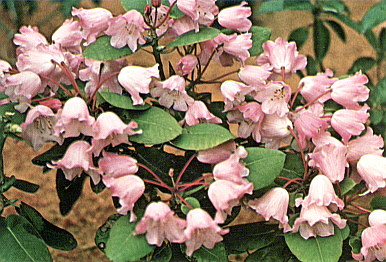R. orbiculare RSF No. 65.350
P. H. Brydon

|
|
R. orbiculare
No. 350 at Caerhays
Photo by P. H. Brydon |
In the collection of the Rhododendron Species Foundation, there are several forms of this outstanding species which were obtained from such notable gardens as the Royal Botanic Garden at Edinburgh, Bodnant, Exbury and Caerhays, plus one or two selections from local gardens. All of them are worthy of a place in any garden and it would be extremely difficult for me to choose a favorite. R. orbiculare is quite distinct in general appearance and there is no confusing it with other species in the genus. The differences between the various clones is mainly in the size of the leaf and the intensity of color in the flowers. A seedling from Exbury has broader leaves than the others and the flower color is deeper pink. The Caerhays plant has a neat, compact habit and in seven years from a graft is now two feet high and three feet wide. When at Caerhays in 1966, the plants which I saw there were close to ten feet and must have been over 40 years old. All of our selections survived five below zero without injury to either flower buds or leaves. They are growing in the open where they have full light until mid afternoon and, so far, have not shown any adverse effects from the summer heat which at times climbs into the high nineties or occasionally higher. R. orbiculare seems to need plenty of light to retain its compact rounded habit which is part of its charm, despite the fact that one prominent English writer referred to it as "a large symmetrical pudding of a bush". In any event, it should be grown where other plants do not crowd in and mar its symmetry. Pudding or not, it is one of the top ten species for all around garden use.